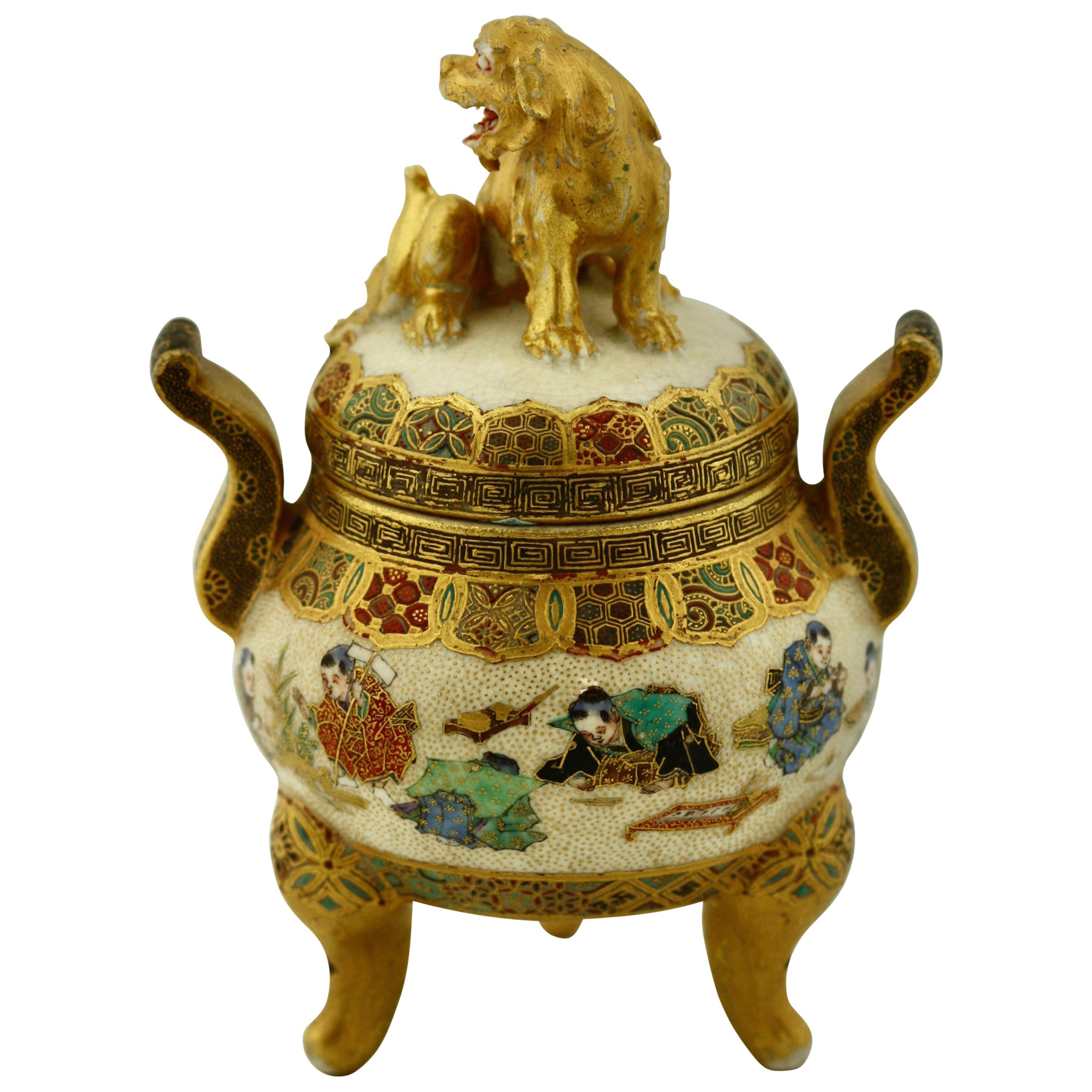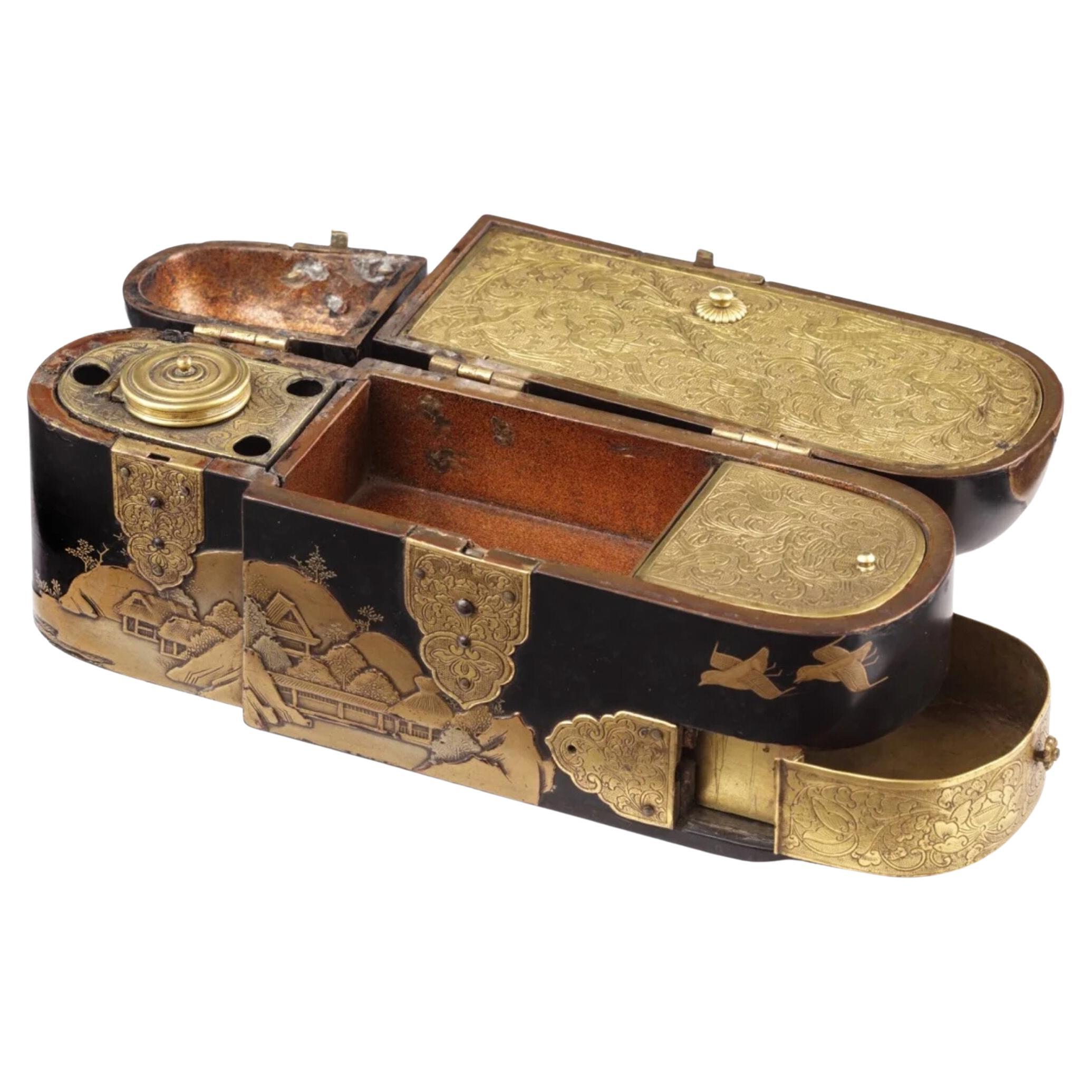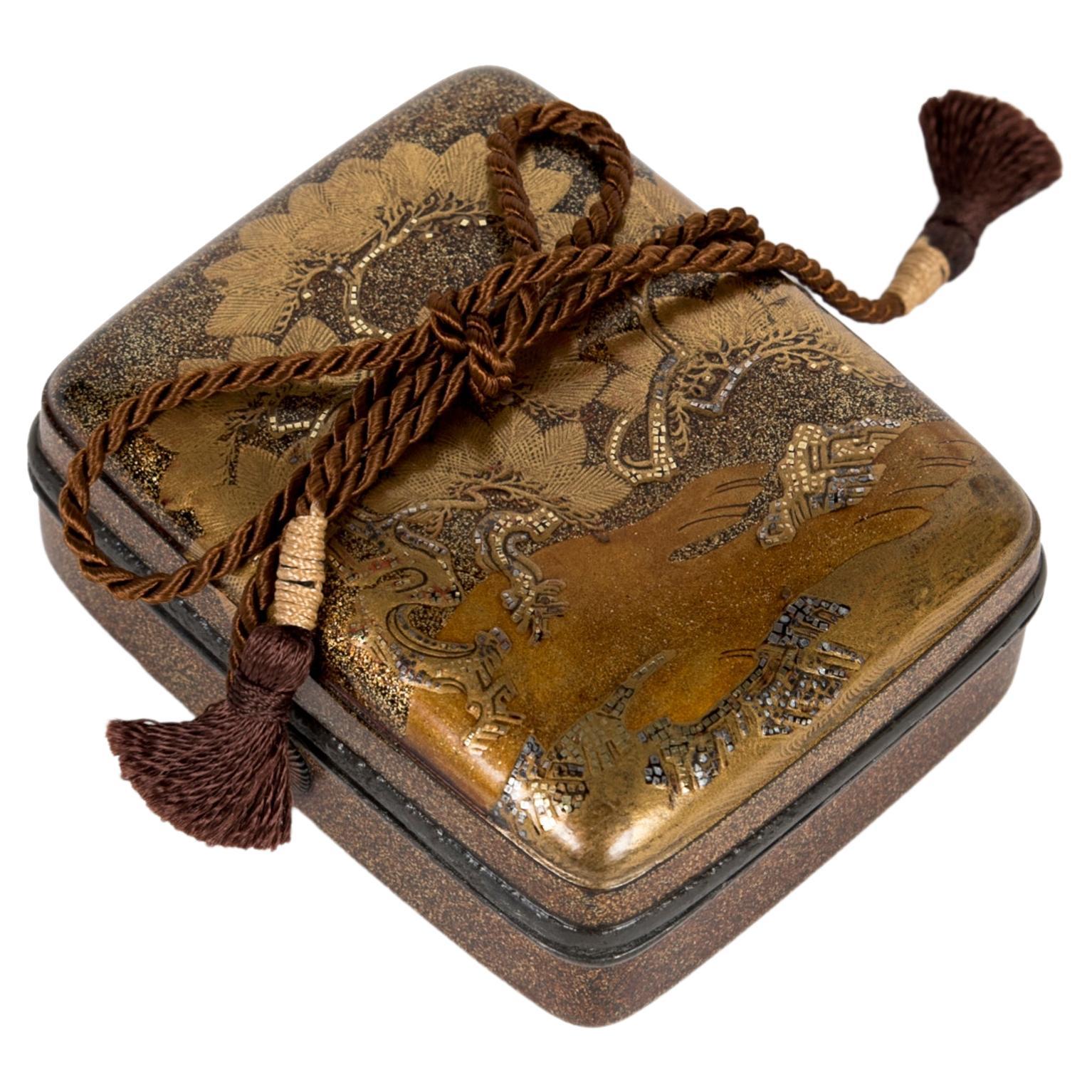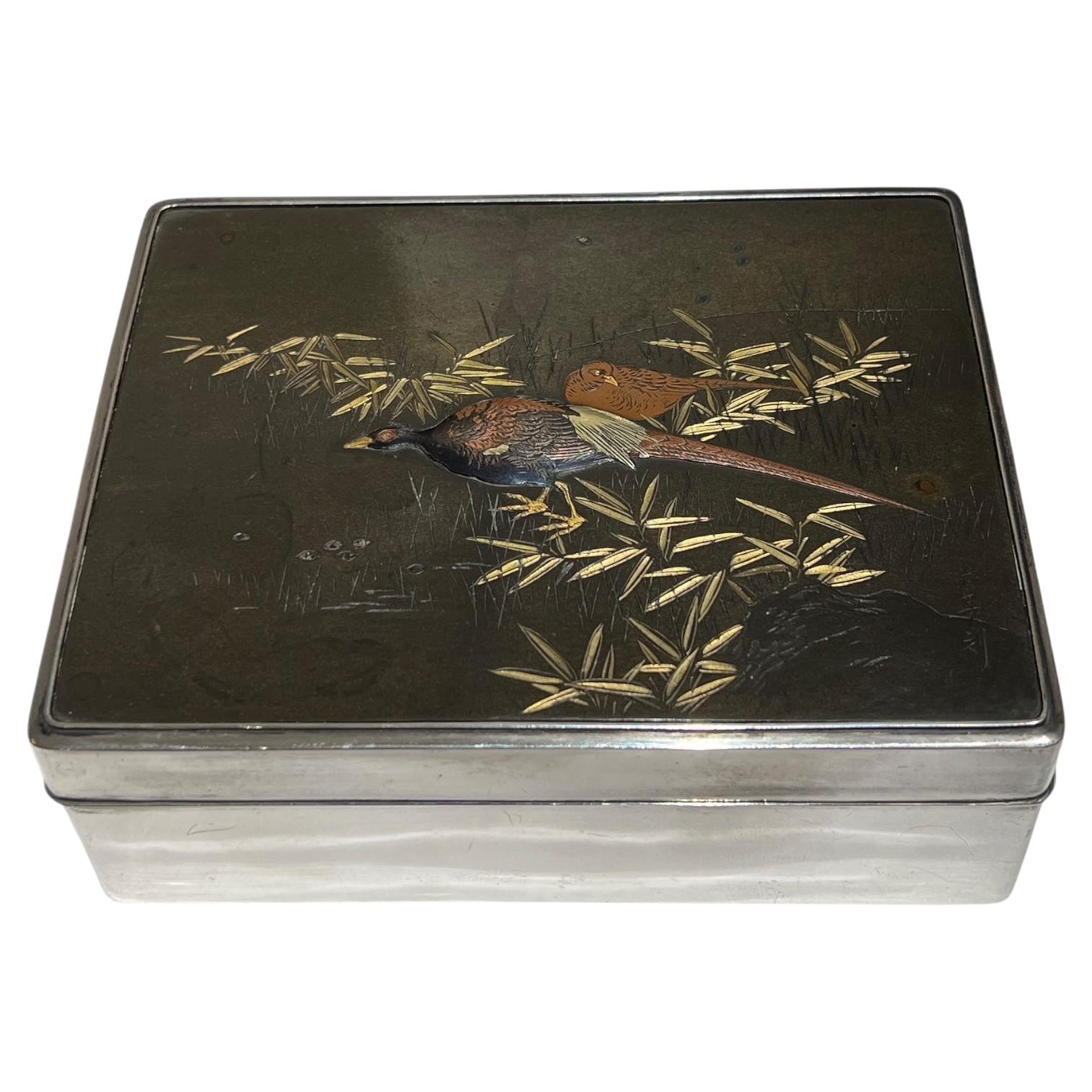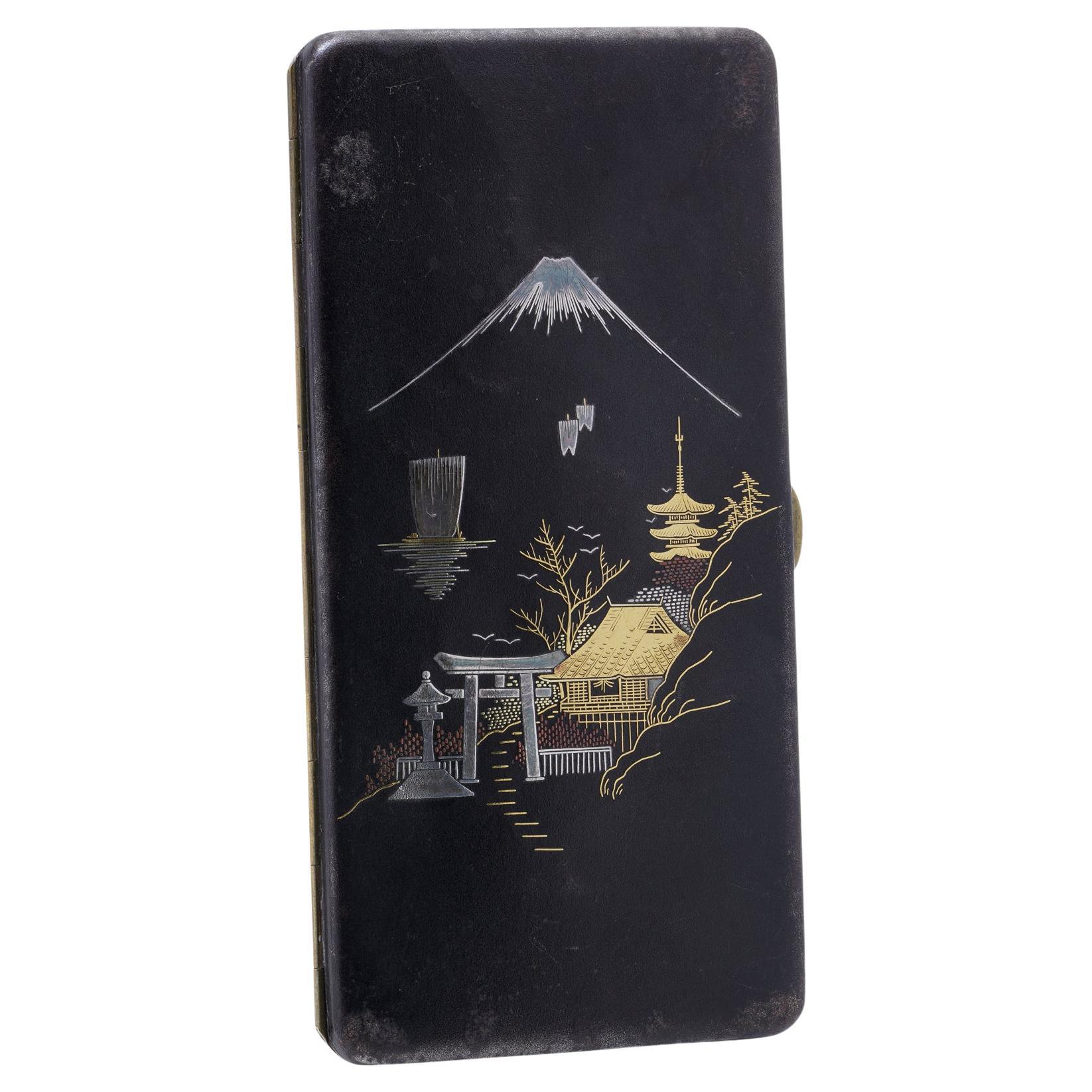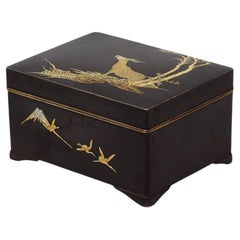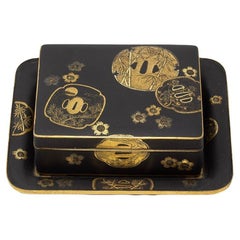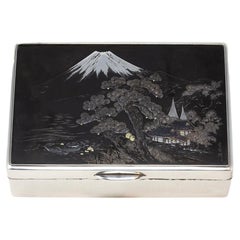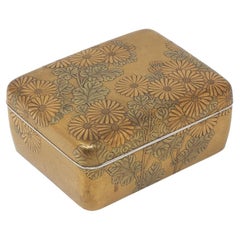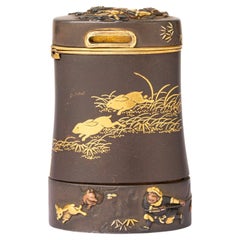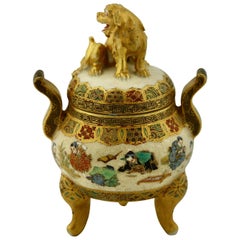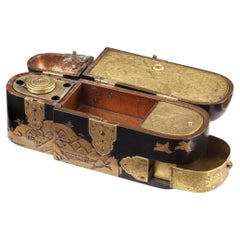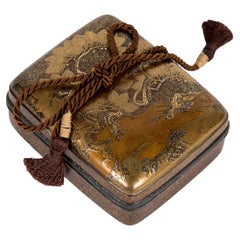Items Similar to Japanese Antique Meiji Period Vesta Case by Fujii Yoshitoyo
Want more images or videos?
Request additional images or videos from the seller
1 of 14
Japanese Antique Meiji Period Vesta Case by Fujii Yoshitoyo
$2,443.60
£1,800
€2,110.16
CA$3,364.85
A$3,765.89
CHF 1,971.31
MX$45,748.74
NOK 25,030.62
SEK 23,620.66
DKK 15,745.50
About the Item
DEPICTING A MYTHICAL HO-O PHOENIX
From our Japanese collection, we are delighted to offer this Japanese Vesta Case by Fujii Yoshitoyo. The Vesta Case extensively decorated with gold flower borders depicting two larger panels, one with a large Ho-o 鳳凰 with trailing tail feathers and the manufactures signature to the bottom right hand corner and the second with birds amongst foliage and chrysanthemum (kiku) flowers. The signature on the bottom right hand corner depicts a version of Mount Fuji which is the mark of renowned metalworker Fujii Yoshitoyo and the vest case dates to the Meiji Period (1868-1912).
FUJII YOSHITOYO
was born in Kyoto, Japan in 1868. Fourth generation metal worker of first rank. He devoted himself to learning about the damascene art and developing the already known techniques used by his family. He left home and moved to Tokyo to develop further and at the age of 35 in 1902 he obtained a patent for his new techniques from the imperial government. In 1909 a second patent was granted to him, he continued to develop his skills and was awarded multiple first class medals throughout his exhibitions and was fortunate enough to sell directly to the imperial household. At its highest point the Fujii factory employer over 200 people mainly exporting sought after objects to Europe and America. During this time he also had his works represented by the Mitsukoshi company. Unlike Komai who use the Zogan (inlay) technique Fujii uses mostly an etching technique on his works.
HO-O
Also referred to as Hoo 鳳凰 or Hou-ou, Ho-o, Hoo-oo, Phoenix in English, Feng 鳳 represents male phoenix, yang, solar Huang 凰 represents female phoenix. In Japan the mythical Phoenix was adopted as a symbol of the imperial household, particularly the empress. This mythical bird represents fire, the sun, justice, obedience, fidelity, and the southern star constellations. The Ho-o bird is a mythical creature in Japanese mythology, adapted from the Chinese Fenghuang. It is a majestic, radiant bird that symbolises peace, prosperity, and the arrival of a virtuous ruler. The Ho-o is often described as having the beak of a rooster, the face of a swallow, the neck of a snake, the back of a tortoise, and the tail of a peacock combining elements of several sacred animals. According to legend, it appears only in times of great harmony and vanishes during times of conflict or corruption. In Japanese art and culture, the Ho-o is often associated with the imperial family, especially the Empress, and is frequently seen in religious architecture, textiles, and lacquerware. It represents not only auspicious power but also the union of yin and yang, embodying balance and divine grace.
CHRYSANTHEMUM (KIKU)
The Kiku flower (Chrysanthemum) holds deep cultural and symbolic significance in Japan. It is considered a symbol of longevity, rejuvenation, and nobility. The Kiku has been associated with the Japanese imperial family for centuries, and the Chrysanthemum Throne is a poetic term for the monarchy itself. With its graceful petals and refined beauty, the flower represents purity and the autumn season. It is featured in festivals, such as the annual Chrysanthemum Festival (Kiku Matsuri), where people display carefully cultivated blooms. The Kiku is also used in family crests, official seals, and various forms of art, reflecting its long-standing role as an emblem of dignity and the refined spirit of Japanese tradition.
VESTA CASE
a small box that houses matches (strike anywhere matches). In England the containers took their name from the term Newton used for his invention, and they became known as “vesta cases”, “vesta boxes” or simply “vestas”. In America the more original term “match safes” was used.
MEIJI PERIOD
was an era of Japanese history that spanned from 1868 to 1912. It was the first half of the Empire of Japan, when the Japanese people began to build a paradigm of a modern, industrialised nation state and emergent great power, influenced by Western countries and aesthetics. As a result of radically different ideas, the changes to Japan were profound and it affected the social structure, politics, economy, military, and foreign relations across the board. The period corresponded to the reign of Emperor Meiji and was preceded by the Keio era and was succeeded by the Taisho era.
Cultural Art during the Meiji Period was of particular interest to the government and they overhauled the art export market which in turn promoted Japanese arts via various world’s fairs, beginning in Vienna at the world fair in 1873. The government heavily funded the fairs and took an active role organising how Japan’s culture was presented to the world including creating a semi-public company named Kiritsu Kosho Kaisha (First Industrial Manufacturing Company). The Kiritsu Kosho Kaisha was used to promote and commercialise exports of Japanese art and established the Hakurankai Jimukyoku (Exhibition Bureau) to maintain quality standards. For the 1876 Centennial International Exhibition in Philadelphia, the Japanese government created a Centennial Office and sent a special envoy to secure space for the 30,000 items that would be displayed. The Imperial Household also took an active interest in arts and crafts, commissioning works by select artists to be given as gifts for foreign dignitaries further emphasising the high quality and importance of Japanese art. Just before the end of the 19th century in 1890, the Teishitsu Gigeiin (Artist to the Imperial Household) system was created to recognise distinguished artists. These artists were selected for their exceptionally high quality wares and talent in their own industry. Over a period of 54 years Seventy artists were appointed, amongst these were ceramicist Makuzu Kozan and cloisonné enamel artist Namikawa Yasuyuki.
- Creator:Fujii Yoshitoyo (Maker)
- Dimensions:Height: 1.78 in (4.5 cm)Width: 1.3 in (3.3 cm)Depth: 0.28 in (7 mm)
- Style:Meiji (Of the Period)
- Materials and Techniques:
- Place of Origin:
- Period:
- Date of Manufacture:Circa 1910
- Condition:
- Seller Location:Newark, GB
- Reference Number:Seller: KRDL1stDibs: LU6971245760652
About the Seller
5.0
Gold Seller
Premium sellers maintaining a 4.3+ rating and 24-hour response times
Established in 2019
1stDibs seller since 2022
37 sales on 1stDibs
Typical response time: 2 hours
- ShippingRetrieving quote...Shipping from: Newark, United Kingdom
- Return Policy
Authenticity Guarantee
In the unlikely event there’s an issue with an item’s authenticity, contact us within 1 year for a full refund. DetailsMoney-Back Guarantee
If your item is not as described, is damaged in transit, or does not arrive, contact us within 7 days for a full refund. Details24-Hour Cancellation
You have a 24-hour grace period in which to reconsider your purchase, with no questions asked.Vetted Professional Sellers
Our world-class sellers must adhere to strict standards for service and quality, maintaining the integrity of our listings.Price-Match Guarantee
If you find that a seller listed the same item for a lower price elsewhere, we’ll match it.Trusted Global Delivery
Our best-in-class carrier network provides specialized shipping options worldwide, including custom delivery.More From This Seller
View AllJapanese Meiji Period Damascene Box by Ashizuki with Gold and Silver
Located in Newark, England
INLAID WITH A GOLD AND SILVER DEER
From our Japanese collection we are pleased to offer this Japanese Damascene Box by Ashizuki. The Japanese Box of re...
Category
Antique 19th Century Japanese Meiji Metalwork
Materials
Gold, Silver, Brass, Iron
Antique Japanese Meiji Period Tsuba Decorated Box and Dish by Fujii Yoshitoyo
By Fujii Yoshitoyo
Located in Newark, England
Original Box and Dish Pair
From our Japanese collection, we are pleased to offer this Japanese Komai Style Box and Dish Fujii Yoshitoyo. The Box of slim rectangular shape seated upo...
Category
Antique Late 19th Century Japanese Meiji Metalwork
Materials
Metal
Japanese Meiji Period Silver and Mixed Metals Cigar Decorative Box by Hidekuni
Located in Newark, England
From our Japanese collection, we are delighted to introduce this Japanese Silver and Mixed Metals Box by Hidekuni. The Japanese Box of large rectangular form lined in a dark asian ro...
Category
Antique Early 1900s Japanese Meiji Cigar Boxes and Humidors
Materials
Gold, Silver
Important Japanese Lacquer Presentation Box Gifted by Japanese President to RAF
Located in Newark, England
PRESENTED BY THE 21ST PRESIDENT OF JAPAN
From our Japanese collection, we are absolutely delighted to bring to market this Important Japanese Lacquer Presentation Box. The Presentat...
Category
Early 20th Century Japanese Art Deco Lacquer
Materials
Lacquer
Japanese Meiji Period Cloisonne Enamel Koro Tsukamoto Hikokichi
By Tsukamoto Hikokichi
Located in Newark, England
Silver Mounted
From our Japanese collection, we are thrilled to offer this Japanese Cloisonne Enamel Koro by Tsukamoto Hikokichi. The Cloisonne Enamel Koro of exceptional quality sh...
Category
Early 20th Century Japanese Meiji Metalwork
Materials
Metal, Enamel
Japanese Meiji Period (1868-1912) Satsuma Kogo Incense Box by Taizan Yohei
By Taizan Yohei IX
Located in Newark, England
DEPICTING BISHAMON ONE OF THE SEVEN LUCKY GODS
From our Japanese Satsuma collection, we are delighted to offer this Japanese Satsuma Kogo by Taizan. The Satsuma Kogo of petit circul...
Category
Antique Early 1900s Japanese Meiji Ceramics
Materials
Ceramic, Earthenware, Pottery
You May Also Like
Antique Japanese Meiji Shakudo Vesta Case By Komai Otojiro
Located in Portland, England
This exquisite Japanese Meiji iron, gold & silver vesta case was made circa 1905 by Komai Otojiro.
(駒井音次郎), the third son of Komai Seibei (駒井清兵衛), a sword fittings maker who establis...
Category
Antique Early 1900s Japanese Boxes and Cases
Materials
Gold, Silver
Satsuma Koro and Cover by Yabu Meizan
By Yabu Meizan
Located in West Palm Beach, FL
A Satsuma Koro and cover by Yabu Meizan, Osaka, 1853-1934, delicately painted with various scenes of children playing, the top with lion finial, raised on...
Category
Antique Early 1900s More Asian Art, Objects and Furniture
Materials
Ceramic
Rare 17th Century Japanese Export Lacquer Medical Instrument Box
Located in Amsterdam, NL
A rare Japanese export lacquer medical instrument box
Edo-period, 1650-1700
L. 19 x W. 6 x H. 8.5 cm
This unconventionally shaped lacquer b...
Category
Antique 17th Century Japanese Edo Lacquer
Materials
Gold
Japanese landscape pine kobako box Edo period 18th century
Located in PARIS, FR
Rectangular black and gold lacquer kobako box decorated with pine trees in a mountain landscape in takamaki-e, kirigane and hiramaki-e lacquer. Background in nashi-ji lacquer. Surmou...
Category
Antique 18th Century Japanese Lacquer
Materials
Gold
Box signed Katsutoshi Koku, Japan, Meiji period (1868-1912)
Located in PARIS, FR
Box signed Katsutoshi Koku, Japan, Meiji period (1868-1912)
Rectangular silver box bearing the Japanese junjin hallmark, signifying pure silver, made during the Meiji period (1868-1...
Category
Antique Late 19th Century Japanese Decorative Boxes
Materials
Silver
Japanese 19th century Komai 24kt. gold and silver Damascene cigarette case
Located in Braintree, GB
An elegant and finely crafted Japanese Komai-style damascene cigarette or card case, dating from the early 20th century (circa 1900–1940), featuring stunning 24‑karat gold and silver...
Category
20th Century Japanese Cigar Boxes and Humidors
Materials
Metal, Gold
More Ways To Browse
Antique Meiji
Japan Antiques Collectables
Emperor Japan
Japanned English Furniture
Antique Inventions
Japan Gold Plate
Antique Patent
Japanese Metal Flower
Japanese Containers
Match Safe
Japanese Metal Plate
Military Box
Japanese Phoenix
Japanese Meiji Period Box
Used Fire Safes
Japanese Metal Box
Antique Swallow
Japanese Enamel Plate

